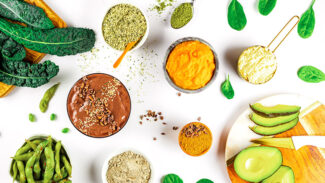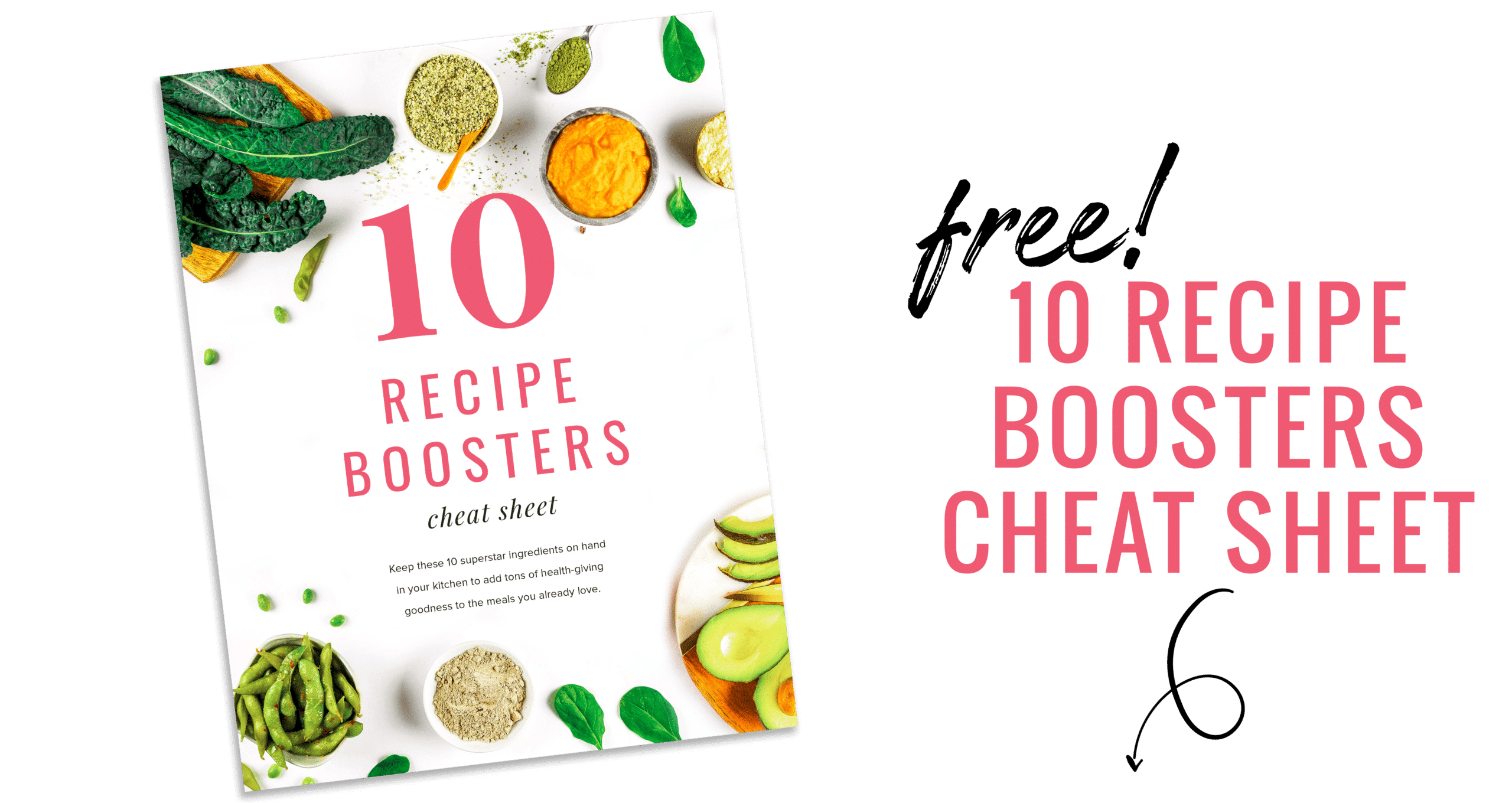Hiya Gorgeous!
When I coach people on adopting a healthier lifestyle (especially during Crazy Sexy You, my 21-day total wellness program), one of my most important pieces of advice is this:
Add before you subtract.
Why? Because we’re trained to think that getting healthy is about deprivation—about taking away. But it doesn’t have to be that way! True, sustainable health is about abundance. It’s about crowding out the stuff that doesn’t serve you with vibrant stuff that brings you joy and fulfillment.
Plus, there’s nothing quite like feeling caged in to strip you of your motivation. Adding rather than subtracting makes you feel nourished and inspired to continue your healthy journey.
That’s why I’m so excited about today’s blog post! We’ve searched high and low to create this list of 10 nutrient-dense foods that are versatile, easy to find and add tons of health-giving goodness to the meals you love.
I even created a handy, downloadable 10 Recipe Boosters Cheat Sheet for you! It’s got everything you need to make these amazing ingredients part of your routine. You’ll get:
- Tips to help you stock your fridge, freezer and pantry with these awesome boosters, what to look for at the grocery store and some of the brands I love.
- Ideas for easy ways to add these ingredients to the meals you already love AND suggested serving sizes.
- Three delicious, simple recipes from Crazy Sexy You to give you a taste of how easy and delicious it can be to nourish your body with nutrient-dense foods.
Alright, let’s dive in!
10 Nutrient-Dense Foods to Supercharge Your Meals
1. Hemp Seeds
The hemp plant has been used for centuries for fuel, paper, cloth and rope, but it wasn’t until more recently that its seeds became popular at mealtime! Not only do they have a subtle, nutty flavor that works well in almost any dish, they also pack a whole lotta nutritional goodness into a very small package. In fact, these little seeds (which are technically nuts!) are more nutrient-dense than any other edible seed.
Here’s why they’re such a good ingredient to add to your favorite meals: Hemp seeds are a complete protein, which means that they have all 9 essential amino acids our bodies need. Plus, they boast 10 g of protein per ounce and no cholesterol or saturated fat, making them much kinder for your body (animals and the planet, too!) than meat. Hemp seeds are also rich in omega-3 and omega-6 essential fats, which are great for your heart and nervous system.
When it comes to incorporating them into your meals, hemp seeds are just as versatile as the plant they come from. Add them to baked goods, smoothies, protein bars, soups, and salads for strong cells, healthy muscles, skin and bones, and a top-notch immune system. Or try them blended with water to make a scrumptious nondairy milk, pressed into a soy-free tofu or as a tasty nondairy parmesan (I’ve included an easy recipe in your 10 Recipe Boosters Cheat Sheet)!
2. Matcha Green Tea
The word “Matcha” comes from the Japanese word matsu (meaning “to rub”) and the Mandarin Chinese word cha (meaning “tea”), and generally refers to the powder made from grinding green tea leaves. It has an earthy, vegetal flavor with a mildly sweet aftertaste.
This bright green powder has quite the history. It’s been combined with hot water to make a popular beverage as far back as the 7th century during the Tang Dynasty in China. At the time, tea leaves were steamed and formed into bricks for easier transport and trade. The bricks were later roasted and pulverized to make a powder that was combined with water and salt to drink.
The concentration of the green tea antioxidant epigallocatechin gallate (kind of a tongue twister—let’s go with EGCG!) is 137 times greater in matcha green tea than brewed green tea (study). EGCG helps prevent cell damage, which protects the brain from aging, supports heart health and boosts your immune system. Compounds in matcha green tea may also help elevate mood, improve concentration, speed up the metabolism and relieve anxiety all at the same time. Hot damn!
Fun fact: Matcha green tea is also great for your skin. Discover its skin-lovin’ super powers in this article by Crazy Sexy Beauty Editor Danielle Shine!
As you can see, matcha green tea is more than just your standard hot sip—try adding it to smoothies, green juices, energy bites, baked goods and homemade granola bars.
3. Dark Leafy Greens
It’s not news that leafy greens are some of the most nutrient-dense foods out there, but did you know that many of them are also mild in flavor and can sneak into smoothies, soups and grain dishes with little notice?
Leafy greens are full of cancer-fighting antioxidants, iron and other health-giving nutrients. Spinach is essentially tasteless in smoothies and just 1 tightly packed cup per day provides enough lutein to help promote eye health—potentially reducing the progression of macular degeneration and preventing cataract surgery (study). The average American only gets about one-sixth the amount of lutein needed to promote eye health each day—let’s change that!
Kale is another great source of lutein. It also contains highly absorbable calcium and iron (more iron per ounce than red meat!) for strong bones, muscles and healthy blood. Kale yeah, am I right?
Add green leafies to any smoothie recipe, or chop ‘em up and use in salads, soups and grain dishes. Strive for at least 1 cup a day to start reaping the benefits these veggie heros have to offer!
4. Avocados
Other than being out-of-this world creamy, super satisfying and the perfect addition almost any salad, toast or dip, avocados also happen to be superstar health boosters! They’re loaded with monounsaturated fats, which are essential to heart health and have also been associated with healthier body weight.
Despite having a higher fat content and calorie count than other fruits, studies have shown that people who eat more avocados have faster metabolisms, slimmer waists, less belly fat and better long-term health than non-avocado eaters (study).
Avocados make a creamy pesto sauce, chocolate pudding (check out the amazing Crazy Sexy You I included in the 10 Recipe Boosters Cheat Sheet!), raw mousse pie and can easily sneak into smoothies. Eat a half of a medium avocado each day to boost your health and well-being!
5. Canned Pumpkin
Cooked, pureed pumpkin (found canned or occasionally in the freezer section of your grocery store) is one of my favorite nutrient-dense foods because it’s a rich source of both beta- and alpha-carotene. In fact, it’s even more jam-packed with ‘em than carrots and sweet potatoes!
Not only are the carotenoids good for your vision and immune system, but research has shown that consuming them from food sources (rather than supplements) helps protect us from cancer—particularly when it comes to preventing breast cancer recurrence (study). Plus, cooking actually increases the potency of the carotenoids, which makes canned pumpkin the ultimate easy recipe booster.
Keep in mind: While you can make your own pumpkin puree by cooking and blending the flesh of your Halloween jack-o’-lantern, that variety has thinner flesh, more water and is less nutrient-dense than the smaller pie pumpkins (sometimes called cooking pumpkins).
Stock up on organic pumpkin in BPA-free cans during Thanksgiving (many stores only stock it seasonally!) to add to baked dishes, risottos, soups, chilis, smoothies and even hummus year-round.
6. Acai Berries
Pronounced “ah-sigh-ee,” these popular grape-sized berries grow on palm trees in the rainforests of Central and South America where they’ve been a dietary staple for centuries. They have a tough, dark purple skin and yellow flesh, and are traditionally soaked to soften up the skin then mashed into a yummy purple pulp.
Acai berries are mild in flavor and are often described as tasting like a cross between unsweetened chocolate and blackberries. They’re higher in antioxidants than ANY other berry—yup, you heard that right! They’re also being researched for their ability to lower bad LDL cholesterol (pilot study), improve athletic performance (pilot study) and protect the brain from damage as we age (study). When it comes to stocking your kitchen with nutrient-dense foods, these purple powerhouses are an absolute must-have.
Acai berries are available as a flash-frozen pulp or in dried powder form to add to oatmeals, smoothies, puddings and energy bites. You might have even noticed acai bowls piled high with fruit, coconut shavings, granola and other delish toppings at your favorite smoothie spot—yum!
7. Almond Flour
Almond flour is made by blanching almonds, removing the outer coating and then processing them into a fine flour. If you like macarons, you like almond flour!
Almond flour is different from almond meal, which is simply ground up whole almonds. Almond flour is gluten-free, low in carbohydrates, rich in protein and fiber, and can replace other flours in baked goods to make them more balanced and nutritious. It adds a mild, nutty flavor to recipes and also makes them more satisfying because of the protein boost.
Use almond flour to dial up the nutritional impact of any baked recipe, including muffins, cakes, pancakes, cobblers or crumbles. See my Recipe Substitution Guide for helpful deets on subbing for regular or all-purpose flour in baked goods.
8. Edamame Beans
Edamame beans are whole, immature green soybeans that are loaded with complete protein and omega-3 fats for your heart and brain. These babies are also easier to digest than most other legumes because they contain different oligosaccharides, which are the indigestible compounds that make you toot!
Edamame beans are one of the healthiest forms of soy because they’re in their natural state, meaning their nutritional content hasn’t been diminished by processing. Although processed soy foods have been scrutinized for potentially having negative health effects, countless research studies have confirmed that unprocessed soy is responsible for lowering cancer risk—especially breast cancer and prostate cancer—and may also improve cancer survival (study).
Edamame beans can be eaten hot or cold, added to stir-fries, salads, eaten as is out of the pod with sea salt, or even mashed into guacamole for a protein-rich dip.
9. Cacao
Raw cacao is made from cacao beans that are cold-pressed. It’s native to the tropical regions of Central and South America where it’s traditionally consumed as a bitter, frothy beverage. Cacao beans can be roasted and made into cocoa, which is then turned into one of the most craved foods on the planet… chocolate!
Cacao is most widely available as an unsweetened powder and as semi-sweet nibs. It’s one of the richest plant sources of iron (up there with dark leafies!) and is incredibly high in magnesium, which is essential for heart health and healthy blood pressure. Magnesium also helps relax the body, can help resolve insomnia, and may help elevate your mood and fight depression (study).
Cacao powder has a similar flavor to cocoa powder and can be used in its place in any recipe (such as smoothies, desserts, chia pudding and chocolate milk).
10. Buckwheat
Buckwheat, originally grown in Southeast Asia, is a grain-like seed (yup, that means it’s gluten-free!) that’s been grown and harvested for over 5,000 years. Until the 1970s, the majority of buckwheat grown in the United States was for animal feed. But as soon as the demand for wheat-free cereals and noodles increased, buckwheat crops became dedicated for human consumption.
Buckwheat is processed into flour, groats, noodles (Ever wondered what soba noodles were made of? Buckwheat flour!), and even tea. Buckwheat is starchy and mainly composed of carbohydrates, but the carbs are slow to digest, making it a great choice for people with diabetes. Buckwheat is also higher in fiber, vitamins and minerals than brown rice and other whole grains. Plus, it’s much lower in phytates than other whole grains, which means that your body can better absorb all of the awesome minerals it contains!
Eating whole grains has been shown to help manage weight, lower your risk of type 2 diabetes and breast cancer, improve digestion, and increase lifespan (check out my blog here for more info on the magic of whole grains). Enjoy buckwheat in place of other whole grains for a hearty dose of nutrition!
Remember: One of the keys to a healthier, more abundant life is adding before you subtract. If you’ve been thinking that it’s time to kick-start better eating habits, go after your health goals or simply add a little more plant-powered goodness to your world, trying out some of these recipe boosters is the perfect place to start.
Your turn: Which one of these nutrient-dense foods will you add to your next meal?! Let me know in the comments below!
Peace and bodacious boosters,

My plant-based cleanse is an easy way to refresh and energize your body in just 72 hours. Find out just how good you can feel when you nourish your body with three delicious, nutrient-packed meals a day. Get started for just $29 here!













Just an FYI, most of the stuff labeled as canned pumpkin is actually butternut squash. The only brand that is definitely pumpkin is Libby’s.
Hi Laurel! I’m the nutrition director here at KrisCarr.com, so I’ll chime in for Kris. Thank you so much for the info on canned pumpkin. Because pumpkin is actually in the same genus as a couple other squash varieties, it’s possible that pumpkin puree could be a combination of a couple different kind of pumpkins and squashes. The important thing to remember is that if your canned pumpkin has a dark orange hue, it’s loaded with health-promoting beta-carotene and is a fantastic recipe booster. xo! – Jen
It’s also super easy to make your own pumpkin purée and freeze in portion sizes. Easy to grow in a garden, too!
Thank you. I enjoyed this article.
So happy to hear that, Melanie! Enjoy those boosters 😉 Mwah!
Thanks Kris,
I plan to add hemp seeds, canned pumpkin (great idea!) and matcha green tea to my shopping list! I eat spinach or greens, buckwheat cereal and avocados several times a week but maybe not enough. Thx for the encouragement!!
Sounds like you’re already doing quite a bit to nourish yourself, Liz. Adding some new ingredients will definitely spice up your routine. Can’t wait to hear what you whip up. xo!
Love this blog. Wrote all the 10 add ons down I will definitely add I cup healthy leafy greens to my daily intake ..:I have macular degeneration ..one eye wet and one eye dry. Thanks Kris. You are awesome
Starting with the leafy greens is a great idea, Patricia. Sending lots of healing love and energy your way. xo!
I love how you put things. Add before you subtract. Oh my. That’s a good one.
I wish you lived next door. You and I would be besties.
We could make each other treats with our favorite recipe boosters! xo 😉
I enjoy edamame though my husband doesn’t; I’ll just use more of them for me. And I didn’t know much about acai berries before; just had heard of the juice. I’ll look for some of that flash-frozen pulp.
You’ll love using the acai in smoothies, Carol—it’s so good! Can’t wait to hear what you think. Mwah!
Thank you so much for sharing this list I will be adding all of these to my kitchen.
Fantastic, Melissa! Sounds like your kitchen is gonna be stocked. xo!
Thanks Kris, I’m happy to say I own all of the ingredients you mentioned, now using them more frequently will be my challenge. Also, I believe it’s the French macarons, not macaroons that incorporate almond flour.
Good catch, Sandee—thanks! xo
I just finished a strawberry smoothie that included hemp seeds, spinach, and cacao powder!
YUM! Talk about a way to start the day, Elizabeth. I wanna have breakfast at your house! xo
Me too! Sounds delicious!
Thank you Beautiful Kris Carr! I use all of these yummy ingredients in my recipes currently except Hemp seeds. I’ve read so many great benefits hemp has. However my daughter made a smoothly and added the suggested amount into the ingredients she usually uses and had a horrible bowel reaction. Now I’m afraid to add Hemp seeds to my diet. Any suggestions or information on why that happened to my 25 year old healthy daughter? I love you so much! I’ve been following you for about 9 years now! I was blessed to see you speak ones! God bless you sweet spirit???
Hi Tonja! I’m the nutrition director here at KrisCarr.com so I’ll jump in for Kris. It’s rare, but possible to have an allergic reaction to hemp seeds. A hemp allergy usually presents itself similarly to a peanut allergy with asthma, chest-tightening, difficulty breathing, and/or nasal congestion rather than digestive upset. It’s possible that your daughter had a reaction to too much hemp too quickly if it was a new ingredient for her. Since hemp seeds are a rich source of polyunsaturated fats, some people require small amounts at first while their digestive systems adjust. To play it safe, however, you may want to check in with an allergist to make sure she’s not having an allergic reaction. Hope that helps! xo – Jen
I was surprised but I already have a lot of them! I have hemp (with chia and flax) for breakfast every morning. I enjoy matcha but usually just get when I go out. Use almond flour in baking. I have boxed pumpkin (have you seen that?). I know I need more greens(which I know). I have never done much with acai berries….so need to explore that more. Great idea to focus on adding before subtracting!
Go you, Debora! Is it the boxed pumpkin in tetra packs? I haven’t seen that as much but know it’s out there! Enjoy exploring the wonderful world of acai ;-). xo!
Happily waitin for the recipe download ; it’s been a few hours
Hey Renee! Did you receive your download? If it didn’t come through, please reach out to my team at [email protected]—they’ll get you sorted. xo!
Can people with Hashimotos use buckwheat. Heard varied answers on this.
Thanks
Hi there! I’m the nutrition director here at KrisCarr.com so I’ll jump in for Kris. There has been some internet information about grains and pseudo-grains possibly having a negative affect on thyroid function. However, I haven’t seen any research to support any of these claims. I suspect there will be more information in the coming months, so stay tuned, and we will too. For now, all signs point to gluten-free diets rich in whole grains as potentially helping thyroid function. Hope that helps! xo – Jen
Hi Kris
You may have already addressed this somewhere but I’ve not seen it.
I’m wondering about the ” controversy ” surrounding eating a larger quantity of grain? Some folks think it’s better to just have lean protein and vegetables and leave the whole grains aside. I love whole grains . Any thoughts ?
Thank you so much for all you do.
Hey Shelley! I’m a big fan of whole grains and they’re definitely a key part of my diet. I encourage you to check out my article on this subject here: https://go.kriscarr.com/blog/whole-grains-health-benefits/. Hope that provides a helpful perspective! xo
Wow.. lots of good information here to glean from. Thanks so much, I am NEVER disappointed about ANY blog by the lovely Kris. Thanks ya’ll.. 🙂
Thanks for your kind comment, Carolyn! So glad to have you here. MWAH!
Hi Kris adore your blog thank you great info ?❗️ Should you grind flaxseeds to get the full benefit from them ❓
I adore cacao! I add nibs to my smoothies, yogurt and homemade trail mix.
Yummmm! Glad to have a fellow cacao lover here, Jennifer 😉
lemons lots of lemons and chia seeds
I wish I could have hemp seeds but due to work, I get drug tested regularly and it’s on the list of banned foods and I miss it so much! Same with my cbd oil! Is there anything else to take with the same properties?
Buckwheat because I didn’t realize it was gluten free!